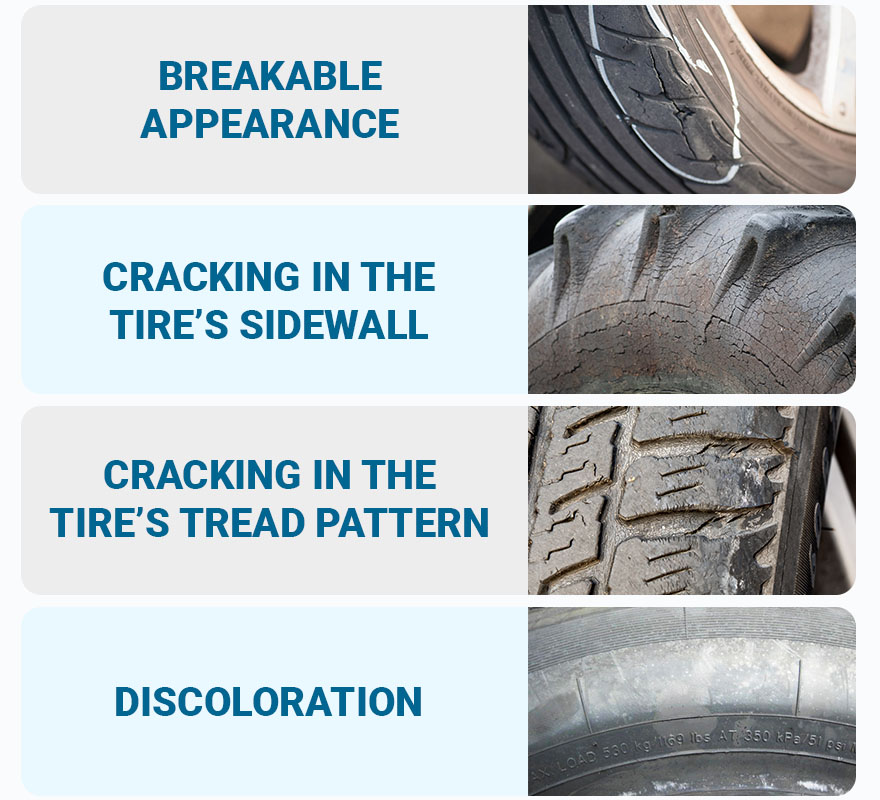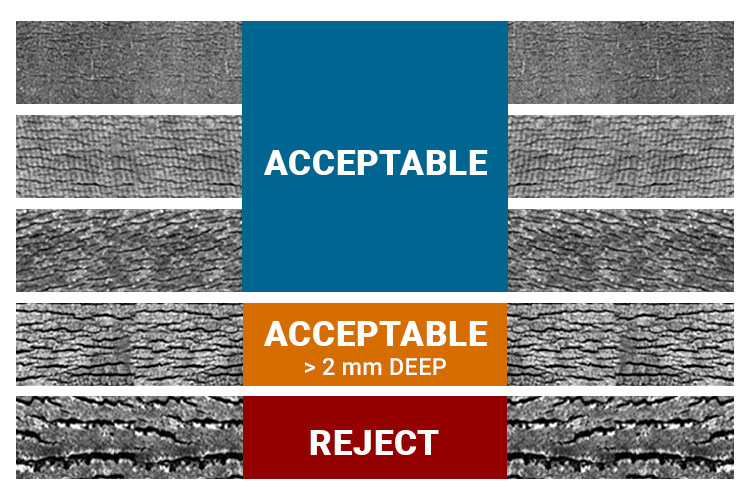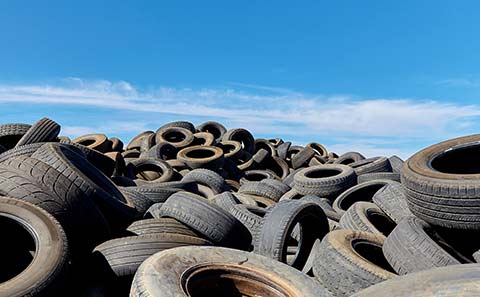Tire dry rot is, sadly, a part of tire life. At the end of their life cycle, tires develop rot with aging. However, that issue can arise for multiple reasons.
So, how long does it take tires to dry rot?
There are different answers as it greatly depends on versatile factors. Furthermore, there is a correlation between dry rot – tire blowout issues. Yet, you won’t be popping tires in the early stages of dry rotting.
Let’s see what this issue is and how can you go about preventing it before needing new tires!
What Is Dry Rot on Tires and How Does It Affect Them?
When talking about dry rot, the first thing to pop into your head might not be tire-related. But, is a dry-rotted tire completely different from that?
Generally, dry rot forms in wood. It is wood decay caused by versatile species of fungi. They eat away at parts of the wood that give it its strength. However, tire dry rot is not the result of organic growth.
If it is not the same, then why do tires dry rot?

Tire dry rot happens when the rubber compound dries out. It appears either because of the natural aging of the tire or by exposing it to improper tire care. When noticing dry rot early signs, the tires can still be saved. Yet, it can quickly become more serious.
It can easily turn into the tire not being able to hold air pressure. It can cause air leaks, dry rot tire blowouts, or even tread separation.
What Does Dry Rot Look Like on Tires?
Tire dry rot can appear in multiple forms. However, as it is known as sidewall cracking, you can guess where this is going. How to tell if tires are dry-rotted?
From minor tire dry rot to tires cracking on their sidewall, dry rot in tires appears in the following ways:
- Sidewall weathering – the sidewall area is harder, with the rubber peeling off the tire sidewall and footprint when it is touched
- Tire Sidewall Cracking – sidewall cracks on tires, whether they are small or cover larger areas, can affect the vehicle’s handling
- Tire Tread Cracking – advanced dry rot spreads sidewall weathering onto the tread area, causing dry rot rubber damage
- Faced Color – when the black color of the tires turns to gray, it means that the tires are experiencing dry rot
Inspect your tires for signs of dry rot tires at least once a year. The best time to inspect your tire is early spring or fall, because, in summer or winter there is a bigger chance that the tire can continue dry rot.
How to Tell if a Tire Is Dry Rotted?
Want to know how to tell if a tire is dry rotted? If you regularly check your tire it can help. When you can see hairline cracks in the tire sidewall, it is one of the signs that your tire is dry rotting. Even the tire peeling on the sidewall or the rubber coming off your tire are also tire dry rot signs.
Another step is also to check your tire’s age. Knowing the answer to “How old is your tire?” can really help you determine if you need new tires or not. Also, check if your dry rot tires warranty is eligible to cover your tires.
In other words, dry rot tires are easy to identify when looking at a standard, new tire and a dry-rotted tire.
In these pictures of dry rot tires, you can see different dry rot variations, from black color fades to the cracks on the tread and the crack in the tire sidewall. Also, there are versions when the tire cracking happens between treads. These represent the main signs of dry rot tires.

How Long Does It Take for Tires to Dry Rot?
Tire tread and sidewalls develop dry rot depending on the conditions they are used in. Sunny, arid climates dry out tires sooner, resulting in dry rotted tire sets after about 5 years. However, humid environments manage to slow the aging process down, lengthening its service life.
These days, there a different tire conditioners to prevent tire dry rot, which can help you protect the tire. However, regular rotation, rebalancing, and air pressure checks improve the tire’s service life. But, if your tire begins to dry rot, don’t wait for cracks in the sidewall of the tire, because, when those appear the tires are old enough to be replaced.
Often, uneven tread wear will appear before dry rot, but that is a different can of worms we can open later.
What Causes Dry Rot on Tires?
Dry-rotted models are also called weather-cracked tires for a reason. While weather damage caused by direct sunlight is the most common reason, tire rot can be the result of many external factors.
And, how do tires dry rot?
These are the causes of a cracked tire:
- Direct sunlight (UV rays)
- Extreme temperatures (both high and low)
- Underinflated tires (running tires with low-pressure levels)
- Improper storage (including near ozone-generating electrical equipment)
- Tires not being used (when they are not in storage)
To make sure your tires don’t develop premature dry rot, be sure to purchase good-quality models. This ensures their longevity as long as they are properly taken care of.
When Is Dry Rot on Tires Dangerous?
Taking care of tires and preventing tire dry rot is crucial for driving safety. A lot of people searching for answers and trying to understand “Why do tires get dry rot?”, “When are cracks in tire sidewall unsafe?”, or “When to replace tires due to dry rot?” These questions are all closely connected to why these cracks happen and how to recognize them.
But, when is dry rot on tires dangerous? Dry rot on tires is dangerous if they are on your tires for a long time.
Why? Because these types of dry rot on the tire become small cracks on tires. Driving with cracks on the tire tread is highly risky. These cracks on the sidewall of the tire become worse without you knowing it and will cause a big problem later.
Here’s why the cracking on tires in between tread is dangerous:
- It seriously weakens your tires, and makes your tire’s sidewall unsafe during the performance.
- The cracks can get deeper, which causes tire blowouts.
- The cracks in tread of tire will just get worse, so patching them is just a temporary solution.
So, be sure that you never ignore rubber cracking on tires, as it can easily result in accidents. It is not recommended to drive with tire rubber cracking at all. Even small cracks can lead to sudden blowouts, which put you and others in danger. Also, cracked tires do not have a long life cycle left, so it would be the best solution to change them.
Let’s walk through the sidewall cracking chart to understand it better. On this dry rot tire sidewall cracking chart you can see which dry rot tire is in an acceptable condition and which is not.
Dry Rot Tire Sidewall Cracking Chart:

How to Fix Dry Rot Tires?
There is a chance of dry rot tire repair. There are a lot of chemicals that can help avoid cracks in tires. You can find a tire spray to prevent dry rot, but they are usually for before dry rot occurs.
Let’s find out which chemicals can help your tires from this condition!
First thing first, you need the best tire protectant for dry rot. You will need a water-based tire oil, a tire decreaser, a large sponge, and a water hose. You need to remove the tires from your vehicle and wheels to see the tread damage on the tire. There will be some areas that are worn out, and some others may have cracks.
If the tire crack is too deep, then you should replace the tire because it can’t be fixed. However, if they are superficial, then you can try to fix them.
With a large sponge put the tire decreaser and apply it on your tire. It would be good to do it twice and then wash it off with warm water. The last step is to let it air-dry for two hours.
After two hours, you need to put water-based oil on the tire’s sidewall, if there are just small cracks in tire tread. This oil creates a layer that protects the tire surface against ozone and UV rays. These things should help to fix some tiny tire tread cracks.
Can You Drive on Dry Rotted Tires?
“Can I drive on dry rotted tires? ” is one of the most popular questions when we are talking about dry rot car tires. Unfortunately, if you see dry rot on tires, it might be a better idea to replace them quickly.
Anyways, as modern technologies and rubber compounds are more advanced, they help tires resist dry rot, so if it sets in, there’s a small chance that you can reverse or fix it.
So, the answer is no, it is not safe to drive on dry rotted tires. Dry rot tires are not that dangerous, but the dry rot can cause cracked tire sidewalls, inflexible tread, and rubber which can fall apart at any moment.
How to Keep Tires From Dry Rotting?
Let’s talk about how to keep rubber from dry rotting! There are a few tips and tricks that can help you prevent dry rot tires, which is important as dry rot cannot be repaired. The first thing when keeping tires from dry rotting is to invest and buy new high-quality tires as these tires are less likely to develop premature dry rot.
To ensure a safe driving experience and to get the most from your tires, always make sure that your tires are properly inflated. If you’re not driving your vehicle then move it to storage and check it every couple of months to protect your tires and vehicle. Also, you can prevent tire dry rot by driving your vehicle regularly.
Besides, for better tires dry rot prevention, you should avoid these few things as well:
- Corrosive chemicals like motor oil or some industrial cleaning solutions.
- Direct sunlight can harm the tires because of the UV rays.
- Freezing or extremely low temperatures.
- Warm and high temperatures.
So, on the question “How to prevent dry rot on tires?”. You should park your vehicles out of direct sunlight, where the temperatures are not too high or too low if it’s possible. If you have a garage, then keep the chemical solutions and electrical equipment away from your tires.
Don’t forget to use good quality dry rot sealant tires to slow down the decaying process and protect the tires. These tips can ensure that your tires can take you safely whenever your road leads.
How to Keep Tires From Dry Rotting in Storage?
Keeping tires in storage increases the chances of establishing dry rot on tires, but there are protection methods and actions you can take to ensure that your tire is going to suffer minimal dry rotting in storage.
If you don’t know how to prevent tires from dry rotting in storage, you need to follow these 5 steps:
Keeping Tires From Direct Sunlight
It is the first step to protect them against dry rot. UV rays can degrade the oil and resins from the tires. These things keep the tire moist and flexible as if they are frequently kept in direct sunlight, they can suffer from dry rotting.
Make Sure That You Put Clean and Dry Tires in Storage
Mud or dirt can increase the chance of dry rotting. It’s because the mud has some moisture that weakens the tire’s surface and it lifts out some of the oils that help keep the rubber flexible. You should clean any dirt from your tire. The best way is to wash them with warm water and hand soap. It’s really important to not use a harsh special cleaning product because they are petroleum-based and they need to be rubbed in, which can only happen when they are driven on.
Store Your Tires at Constant Temperatures
If possible, try to store your tires at constant temperatures. Too high or too low temperatures can speed up the dry rotting of tires. Also, large temperature swings can lead to dry rotting as they speed up evaporation from the tires.
Remove Tires From Your Vehicle
Don’t forget to remove tires from your vehicle if you are not going to use them for more than three months. Dry rotted tires can be restored and they can be driven again, but only if they do not lead to cracks on tire sidewall. These cracks happen when the tires hold up the weight of the vehicle for a long time. Also, you should remove the entire wheel as well, because they can also stretch the rubber around the rim which also cracks the tire’s sidewall.
Store Tires in Airtight Bags
If you remove your tires from the vehicle, then it would be best to keep them in airtight bags. Oxygen is the main contributor to dry rotting. In other words, storing tires in bags will prevent and protect your tires against dry rot, compared to storing them unbagged.
Frequently Asked Questions
How Much Dry Rot Is Too Much on a Tire?
Rubber dry rot can be dangerous when the cracks between tire treads and on the sidewall are deep and severe. Such tire sidewall cracking is an indication that the tire is going to fail. When tire rubber reaches severe levels of cracking, it should be changed immediately.
Are Small Cracks in Tires Normal?
Cracks on tires can be normal, as they are an indication of tire aging or improper care. However, whether it is due to aging or damage, they are signs of a bad tire. Severely dry rotted tires should be changed immediately, while barely visible tire cracks don’t pose an immediate threat.
When to Replace Dry Rot Tires?
losely connected with miles driven, driving styles, terrains you drive on, and of course, the vehicle you drive. However, no matter how old a tire is, if you notice cracks in the tire’s sidewall, you should replace your tire immediately.
How Long Can You Drive on a Tire With Wires Showing?
’t drive on tires with wires showing! Change the tire immediately. Wires showing on tires make those models extremely dangerous and no amount of driving should be attempted with them. Look into getting a replacement tire as soon as possible.


